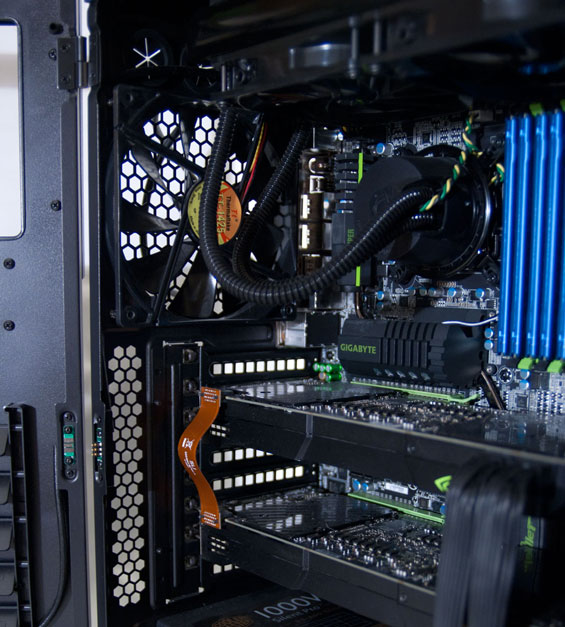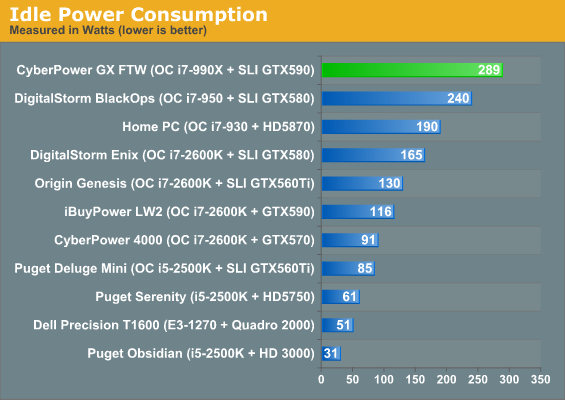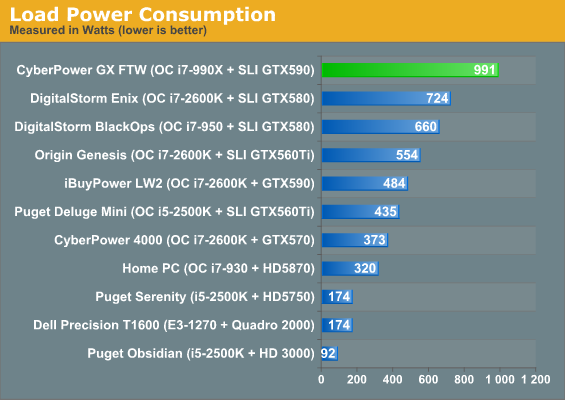CyberPowerPC Gamer Xtreme FTW: Performance at Any Cost
by Dustin Sklavos on June 1, 2011 1:05 PM ESTBuild, Noise, Heat, and Power Consumption
The Thermaltake Level 10 GT's unique engineering does effectively sequester noise and heat, keeping the bulk of it largely well arranged around the CyberPowerPC Gamer Xtreme FTW's processor and video cards. Many of my complaints regarding build quality would be directed more at Thermaltake than CyberPowerPC, but we'll save those for when I tackle the enclosure on its own. Suffice it to say there are a couple of issues with the way the case is designed that are patently unacceptable for an enclosure that costs north of $250.
What CyberPowerPC has understood in its design here is something that I've been experiencing with some of the cases I've reviewed as of late: the number of or size of the fans used in a build is nowhere near as important as it seems. There are at least six fans in the Gamer Xtreme FTW, four alone of which are mounted to the 240mm radiator in a push-pull configuration that exhausts out of the top of the case. But the thing is, if you use a lot of fans, they don't have to work anywhere near as hard as if you try to just use a couple to keep the noise down. Likewise, a single well-placed fan can cool a lot more effectively while not working as hard than if you just place a bunch of fans in your enclosure and call it a day. As a result, the Gamer Xtreme FTW is actually reasonably quiet when idling. It's only under load that it gets noisy, and even then, it's nowhere near as offensive as you'd expect.

The spacing of the two cards is about as optimum as you're going to get, so clearly CyberPowerPC picked the right motherboard for this build. As for heat management, well, take a look for yourself:

Now admittedly I was running the Gamer Xtreme FTW with the sliding glass door open when the outside weather was less than 60F, but we can probably all agree these are excellent thermals, especially when you take into account the reason why I tested this tower with that door open.


That's right, under load it draws nearly a kilowatt. Even idle power is obscenely high. And the Gamer Xtreme FTW dumps all that heat right out in whatever room it happens to be running in. It was during testing this tower that I fully grasped why I could never personally live with a computer like this: it draws an obscene amount of power under load, and that power means it throws a tremendous amount of heat. Those who live in Antarctica or Siberia might appreciate this more than someone in Northern California.
When overclocking and performance tuning, there's generally an inflection point where the processor starts requiring copious amounts of increased voltage with diminishing returns on the core clock. My old i7-930 could hit 4GHz stable on stock voltage, or I could reduce the voltage by 0.075V and still get 3.6GHz. The increased heat (and correspondingly increased noise from the tower having to deal with that much heat) for an extra 400MHz wasn't worth it. A system like this blows right past that inflection point, so under load that processor is going to draw a ridiculous amount of power.
But what about the incredibly high idle current? DigitalStorm was able to run SLI GTX 580s and a heavily overvolted i7-2600K, but the Enix idled at a little over half where the GX FTW sits. The reason for that is simple and one that anyone who's been keeping up with these desktop reviews has probably seen coming: a "badly tuned" overclock. The GX FTW runs its i7-990X at 4.5GHz at all times, with the voltage set at 1.45V. The pair of GTX 590s can idle, but that processor is always going to be drawing a mountain of power. Its idle current is more than some of our test units have pulled under load.
If you're interested in buying a hex-core, quad-SLI, heavily overclocked system for five grand, presumably you have a need for all that performance. In that case, maybe there's an added measure of stability to be had by not worrying about dynamic voltages and multipliers. On the other hand, if you have the FTW powered on just 12 hours per day, sitting idle, your power costs will be around $125 per year (plus the additional cost of AC during hotter months). If you're a professional gamer that "needs" this much performance to stay competitive, and you game eight hours per day to keep your mad skillz sharp, you would bump up your yearly power bill around $300. But I doubt anyone who would actually buy this sort of system will really care about power or cooling costs.
















32 Comments
View All Comments
Dustin Sklavos - Wednesday, June 1, 2011 - link
I'll admit I'm not a huge fan of the case's aesthetics, but the thermals are stellar. It gets the job done.nuker - Wednesday, June 1, 2011 - link
Can we have the noise levels please?Excellent review! I'm just wondering if it's better to have an Ibuypower's Erebus system rather than a Level10 case, they cost nearty the same with equal hardware specs.
Dustin Sklavos - Wednesday, June 1, 2011 - link
I can try getting an Erebus in for review, but in the meantime I'll also be reviewing the Level 10 GT on its own sometime soon.IdioticLoginSystem - Wednesday, June 1, 2011 - link
It's me or it's not SO impressive as it seems?The Geforce GTX 590 aren't as impressive as the HD 6990 in the benchmarks I've seen. In fact, the 6990 beats the crap out of them in high resolutions with AA activated, due to their higher vRAM size. Plus, 6990 clocks nearly 300 mhz faster, and while Fermi architecture is superior, 300 mhz is, well....a lot of difference.
The SSD is also a bad choice. Intel has never done any SSD comparable to an OCZ Vertex 3 (or an OCZ PCIe-based one, aka VeloDrive). Besides, who the hell needs 2 terabytes of disk space?
I don't know if it's performance-wise or what, but 6x2 GB's modules seems a waste to me. If you want to upgrade (it's "only" 12 gb's of RAM after all), you've to throw away one or more of them.
At least the price seems "correct", but to claim this is the "fastest system ever"...I'm not impressed at all.
szimm - Wednesday, June 1, 2011 - link
I kind of agree with you on the graphics part, but the difference is neglible. The SSD is not a bad choice, though - the Intel 510 is probably the fastest option out there right now, according to benchmarks, and assuming you have an MB that supports 6Gbps. And yes, the RAM configuration is horrendous - a system like this should have absolutely no drawbacks. At that price point, nothing less should be expected. But - there's bound to be a few idiots with enough disposable income. I'm sure CyberPower (hate that name) is betting on it...Dustin Sklavos - Wednesday, June 1, 2011 - link
The difference between the 6990 CF and GTX 590 SLI is going to seem at least somewhat academic given the results I had with the GTX 590 SLI config. And personally, I'd make the trade-off: the GTX 590 runs much quieter than the 6990 does.3DVagabond - Wednesday, June 1, 2011 - link
This system was built to sell to people with some, but not a lot, of PC knowledge. Thus Intel drives and Geforce graphics. The 6x2 GB RAM just helps to confirm it. It's cheaper and still says "12GB" on the side of the case. Although it's not the way anyone would build a system for themselves. Add to it a case with aesthetics that set it apart, and the thinking that went into the design seems pretty obvious.I'm not saying it's a bad design from a business POV. Just the opposite. Well thought out on the marketing teams side.
IdioticLoginSystem - Wednesday, June 1, 2011 - link
The price WOULD BE correct if that config is tagged at "$1,565"If "As configured $5,017" is the full system with the specs we see, then it's pure and absolute crap. If Sandy Bridge-E gets out before October, I'll be able to build a system that kicks it's ass for 500$-1000$ less.
Spazweasel - Wednesday, June 1, 2011 - link
With that power draw, consider the possibility that you will need a dedicated circuit to power it. It's drawing as much power as a microwave (9 amps@110v), and microwaves typically get their own circuit. Most home circuit breakers are 20-amp units (again, US voltage), and you don;'t want to exceed 75% of capacity. Add in the power draw of a pair of 30" monitors and a sound system, and you don't have much room left for anything else on that circuit.Also consider your line conditioning. At that power draw, the run-of-the-mill 700Va home UPS ain't gonna do it. You'll want to protect your $5000 worth of computers and $2000 worth of multiple 30" monitors (you're not getting this to drive a 24" 1920x1200 display, after all), and to do so at that load you're looking at another kilobuck; your UPS will have to be a low-end data center piece instead of a consumer piece.
Is this worth $5000 to you? The better question is, is it worth $8000? If so, go for it. Just consider all the extra expenses, above and beyond the power bill and the computer itself.
meshugge - Wednesday, June 1, 2011 - link
Have to say that I bought a $3K Cyberpower pc last month based on recent reviews here - they sent me a defective machine and have not responded now to three separate emails over the last two weeks requesting support or return information. If that is the service they provide to customers, not quite sure why you are bothering to review their machines.